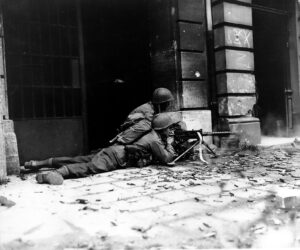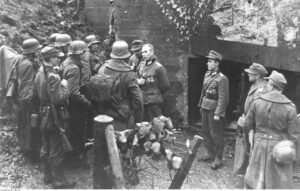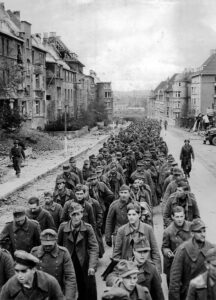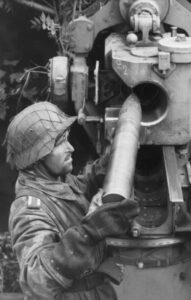
 The Nazis were famous for taking no thought for the people around them, as long as they go what they wanted. Achen, Germany was one example of that lack of care and compassion. In October of 1944, the city has been incorporated into the Siegfried Line (known as the Hindenburg Line to the Americans). The Siegfried Line was the main defensive network on Germany’s western border.
The Nazis were famous for taking no thought for the people around them, as long as they go what they wanted. Achen, Germany was one example of that lack of care and compassion. In October of 1944, the city has been incorporated into the Siegfried Line (known as the Hindenburg Line to the Americans). The Siegfried Line was the main defensive network on Germany’s western border.
Fighting around Aachen began as early as the second week of September. It was a period of time known to the Germans as the “First Battle of Aachen.” At that time, the city was defended by the 116th Panzer Division. A panzer division was “a combined arms formation, having both tanks, (German: Panzerkampfwagen, which means armored fighting vehicle, usually shortened to “Panzer”), mechanized and motorized infantry, along with artillery, anti-aircraft and other integrated support elements.” The Panzer Division was under the command of General Gerhard von Schwerin. The proximity of Allied forces made the city officials very nervous, and quickly caused the majority of the city’s government officials to desert their post, long before the evacuation of its citizens was complete. While most of us would be furious over this desertion, Hitler had taken it one step further, by stripping each of the deserting officials of their rank and sending them to the Eastern front as privates. Rather a fitting punishment, but I seriously doubt if Hitler cared about the people. He wanted the officials there for war purposes. Then, in the greatest atrocity, instead of continuing the evacuation, von Schwerin decided to surrender the city to Allied forces. He would have had no idea if the Allies would trat the people kindly or not, but then he really didn’t care. However, on September 13, before he could deliver a letter of capitulation he had written, von Schwerin was ordered to launch a counterattack against American forces penetrating southwest of Aachen. Reluctantly he followed the orders, probably because he fear Hitler more than the Allied forces. He used elements of his panzergrenadier (the motorized infantry) forces. The German general’s Treasonous act when he attempted to surrender the city was irrelevant now, because his letter was never delivered. Unfortunately for him, it fell into the hands of Adolf Hitler, who ordered the general’s immediate arrest. He was replaced by Colonel Gerhard Wilck.
The United States’ VII Corps continued to push German defenses, despite the resistance they encountered on September 12th and 13th. Between September 14 and 16, the US 1st Infantry Division continued its advance in the face of strong defenses and repeated counterattacks, ultimately creating a half-moon arc around the city. Unfortunately, this slow advance came to a halt in late September, due to the supply problem, and the diversion of existing stocks of fuel and ammunition for Operation Market Garden in the Netherlands.
During what would then be known, to the Germans at least, the second Battle of Aachen, American and German forces in and around Aachen, Germany, fought for supremacy between October 2 and 21, 1944. The 
 Allies needed the city to advance into the industrialized Ruhr Basin, whether they wanted to fight a battle in the city or not. Although most of Aachen’s civilian population was evacuated before the battle began, much of the city was destroyed and both sides suffered heavy losses. The people would have nothing to come home to. It was one of the largest urban battles fought by US forces in World War II. Aachen was also the first city on German soil to be captured by the Allies. The battle ended with a German surrender, but their tenacious defense significantly disrupted Allied plans for the advance into Germany. The Battle of Aachen had cost both the Americans and Germans dearly; the former suffered over 7,000 casualties, while the latter lost over 5,000 casualties and 5,600 taken prisoner.
Allies needed the city to advance into the industrialized Ruhr Basin, whether they wanted to fight a battle in the city or not. Although most of Aachen’s civilian population was evacuated before the battle began, much of the city was destroyed and both sides suffered heavy losses. The people would have nothing to come home to. It was one of the largest urban battles fought by US forces in World War II. Aachen was also the first city on German soil to be captured by the Allies. The battle ended with a German surrender, but their tenacious defense significantly disrupted Allied plans for the advance into Germany. The Battle of Aachen had cost both the Americans and Germans dearly; the former suffered over 7,000 casualties, while the latter lost over 5,000 casualties and 5,600 taken prisoner.


Leave a Reply